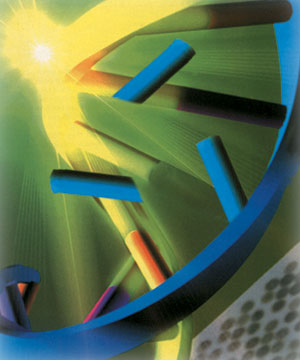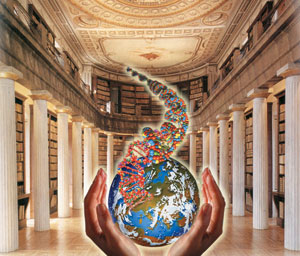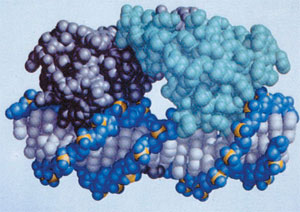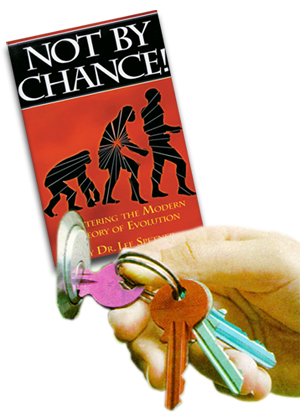The NAS's Errors Regarding Mutations
The National Academy of Sciences suggests that mutations provide the necessary genetic variation for evolution, and refers to them as follows: "They may or may not equip the organism with better means for surviving in its environment." (Science and Creationism, p. 10). In fact, however, contrary to what the NAS authors claim, mutations do not lead to beneficial characteristics, and all experiments and observations on this subject have confirmed this fact.

Mutations are random changes in a living thing's DNA, the molecule in which its genetic information is contained.
Mutation refers to random changes in an organism's DNA, the molecule in which its genetic information is stored. Scientists compare DNA to a data bank or large library. Just as the random and unconscious addition of letters to any of the books in a library—or indeed any change in the order of the letters of such a book—will ruin the sense of the relevant words and sentences, so too does genetic mutation in organisms have an information-destroying effect. Mutation, which acts on the complex information in the DNA in a random and unconscious manner, harms the DNA, and therefore harms the organism bearing the DNA. At best, it may have no effect at all. However, mutations can never add any new information to DNA, and do not make any kind of improvement in the organism. Not a single instance of this has ever been observed.
The latest example of this is the negative effects of mutations on human beings. In recent years, thousands of diseases have been found to be caused by genetic mutations. Genetics textbooks list some 4,500 different genetic diseases. Such diseases caused by genetic mutations include Down's syndrome, sickle-cell anemia, dwarfism, mental impairment, cystic fibrosis, and certain forms of cancer. The reason why generations of people were born deformed or sick because of radiation at Hiroshima, and more recently Chernobyl, is again mutations.
Pierre-Paul Grassé, former president of the French Academy of Sciences and author of the 35-volume Traité de Zoologie, likened mutations to spelling mistakes in one of his papers, and said that they could never give rise to evolution:
Mutations, in time, occur incoherently. They are not complementary to one another, nor are they cumulative in successive generations toward a given direction. They modify what preexists, but they do so in disorder, no matter how… As soon as some disorder, even slight, appears in an organized being, sickness, then death follow. There is no possible compromise between the phenomenon of life and anarchy.1

Scientists compare DNA to a data bank or a large library.
As Grassé states, mutations bring disorder to exceedingly ordered structures. Genetic mutations might be compared to an earthquake or to hurling a clock against a wall. In the same way that an earthquake cannot improve a city, nor a violent impact a clock, so too genetic mutations do not improve living things, but rather harm them. Evolutionists are aware of this, but still propose mutations as the mechanism that brings about evolution. In order to better see the evolutionists' inconsistencies in this area, it will be useful to include some statements on the harmful effects of mutations on living things made by evolutionist scientists.
Francisco J. Ayala, of the University of California, Irvine, a professor of biological sciences and philosophy:
High energy radiations, such as x-rays, increase the rate of mutation. Mutations induced by radiation are random in the sense that they arise independently of their effects on the fitness of the individuals which carry them. Randomly induced mutations are usually deleterious. In a precisely organized and complex system like the genome of an organism, a random change will most frequently decrease, rather than increase, the orderliness or useful information of the system.2
James F. Crow, head of the Genetics Department at the University of Wisconsin and an expert on radiation and mutation:

If letters are added randomly and unconsciously to any one of the books in a library, various words and sentences in that book will lose their meaning. The same thing applies to DNA. A random and unconscious intervention in the complex information in DNA—in other words, a mutation—will damage DNA, and consequently the organism itself. At best, a mutation may have no effect at all on the organism.
Almost every mutation is harmful, and it is the individual who pays the price. Any human activity that tends to increase the mutation rate must therefore raise serious health and moral problems for man.3
A random change in the highly integrated system of chemical processes which constitute life is almost certain to impair it—just as a random interchange of connections in a television set is not likely to improve the picture.4
The biologist Dr. Mahlon B. Hoagland:
The information that resides in organisms that are alive today . . . is far more refined than the work of all the world's great poets combined. The chance that a random change of a letter or word or phrase would improve the reading is remote; on the other hand, it is very likely that a random hit would be harmful. It is for this reason that many biologists view with dismay the proliferation of nuclear weapons, nuclear power plants, and industrially generated mutagenic (mutation-producing) chemicals.5
You'll recall we learned that almost always a change in an organism's DNA is detrimental to it; that is, it leads to a reduced capacity to survive. By way of analogy, random additions of sentences to the plays of Shakespeare are not likely to improve them! . . . The principle that DNA changes are harmful by virtue of reducing survival chances applies whether a change in DNA is caused by a mutation or by some foreign genes we deliberately add to it.6
The well-known mathematician Dr. Warren Weaver:
Moreover, the mutant genes, in the vast majority of cases, and in all the species so far studied, lead to some kind of harmful effect. In extreme cases the harmful effect is death itself, or loss of the ability to produce offspring, or some other serious abnormality.7
Many will be puzzled about the statement that practically all known mutant genes are harmful. For mutations are a necessary part of the process of evolution. How can a good effect—evolution to higher forms of life—result from mutations practically all of which are harmful? 8
Weaver's question is a very important one, and demands an answer from evolutionists: How can a good effect—evolution to higher forms of life—result from mutations practically all of which are harmful?

Scientists compare mutations to an earthquake in a city or a clock being thrown hard against a wall. In the same way that earthquakes do not develop cities, and hurling clocks against walls does not improve them, mutations do not improve living things, but rather damage them.
I.L. Cohen, a member of the New York Academy of Sciences, says: "To propose and argue that mutations even in tandem with 'natural selection' are the root-causes for 6,000,000 viable, enormously complex species, is to mock logic, deny the weight of evidence, and reject the fundamentals of mathematical probability."9 This statement unmasks the absurdity of those who believe that all life forms are the work of mutation and natural selection.
Another reason why evolutionists' claims regarding mutation are not credible is that just as there are no beneficial mutations, there is no mechanism in nature that might bring together and protect these useful mutations. For example, a blind creature will need a few mutations in order to possess an eye and an optic system. Expecting "beneficial" mutations accurately directed towards the eye, optic nerves, and visual center in the brain to keep occurring among that creature's descendants is to believe in the impossible. Therefore, consciousness and power are required to continue in that creature's descendants. Furthermore, they must foresee that the creature will need to see the outside world, they must provide all the necessary genetic information regarding vision and the eye, and they must carefully bring beneficial and accurate mutations together down the generations. Yet, there is no such consciousness and intelligence in nature.
Several evolutionists have drawn attention to this impossibility. For example, Professor Kevin Padian, of the University of California at Berkeley, asks whether random mutations in nature give rise to living species:
How do major evolutionary changes get started? Does anyone still believe that populations sit around for tens of thousands of years, waiting for favorable mutations to occur (and just how does that happen, by the way?), then anxiously guard them until enough accumulate for selection to push the population toward new and useful change? There you have the mathematical arguments of neodarwinism that Waddington and others rightly characterized as "vacuous".10
Grassé has this to say on the same point:
Mutations, in time, occur incoherently. They are not complementary to one another, nor are they cumulative in successive generations toward a given direction.11

In order for a gilled fish to become a creature breathing with lungs, it would need a great many mutations. To expect "beneficial" mutations and ones "aimed directly at the transition to the lung" to keep occurring is to believe in the impossible.
Even if we grant what evolutionists can never actually demonstrate and accept that "favorable mutations" have come about in the necessary quantities, this still does not save the theory of evolution. Some important calculations by the Israeli bio-physicist Dr. Lee Spetner, who has worked at some of the most eminent universities in the world, such as MIT and Johns Hopkins, were brought to the attention of the scientific world in the book Not By Chance. In this book, which questions neo-Darwinism, Spetner employs the figures given by evolutionist authorities (such as mutation frequency and the ratio of "favorable mutations" to all mutations) and makes a detailed calculation of whether it is possible for one species to change into another. His conclusion is striking: Impossible! Even if we accept the theoretical existence of "favorable mutations," which have never been observed in experiments, it is still impossible for these to accumulate consecutively and in the right direction in a living species. It is also impossible for them to be permanent due to the disadvantages they bring with them, and thus it is impossible for a new species to emerge.
No evolutionist has been able to give a satisfactory response to Spetner's calculation.
"Favorable mutations" that never were
As we have seen, mutations are harmful to living things and no example of a beneficial mutation has ever been observed. The examples put forward by evolutionists as "beneficial mutations" all actually consist of distortions. In none of these examples have the benefits necessary for the evolution of an organism—that is, an increase in genetic information—ever come about. Let us now examine why the instances of "beneficial mutations" put forward by evolutionists are not actually useful at all, and cannot lead to evolution.
Sickle-cell anemia:
Sickle-cell anemia stems from an inherited fault in the code necessary for the production of the hemoglobin molecule, which helps carry oxygen in the blood. As a result of this fault, the structure of the hemoglobin molecule is defective and its ability to carry oxygen is severely impaired. The normal circular shape of the cells which carry hemoglobin becomes deformed and turns into a sickle shape. Since people with sickle-cell anemia gain a resistance to malaria, evolutionists describe this as a beneficial mutation. The fact is, however, that there is no increase in complexity nor any improvement in the organism's functions; on the contrary, there is a defect. Sufferers from sickle-cell anemia experience impaired development, a lack of immunity to infection, chronic organ damage due to clogged veins, poor organ function and organ deficiencies, and lack of energy.

The unhealthy appearance of a damaged blood cell
Sickle-cell anemia is a serious disease stemming from an error in the gene that encodes the molecule hemoglobin, which is responsible for carrying oxygen in the blood—in other words, from a mutation.
It is astonishing that this example of mutation, dealt with in the chapters on diseases of the blood in medical text books, should be seen as "beneficial." It is irrational for evolutionists to say that sufferers' resistance to malaria is a gift to them from evolution, for which reason the mutation in question is a favorable one. That claim is just as illogical as telling a blind man he has an advantage because he cannot be blinded by the sun.
Bacterial resistance to antibiotics:
Another example of evolutionists' "beneficial mutations" is the resistance of bacteria to antibiotics. Like all the other examples, this one, too, is a deception.
It is no secret that bacteria gradually develop a resistance to antibiotics over time. What happens is this: Most bacteria subjected to an antibiotic die, but some remain unaffected by it, and multiplying rapidly they come to comprise the entire population. In this way, the entire population comes to be immune to the antibiotic.
Evolutionists, however, claim that bacteria evolve according to the conditions in which they find themselves. The truth is, however, rather different. The Israeli biophysicist Professor Lee Spetner is one of the figures who have carried out the most detailed studies in this area. Professor Spetner explains how this resistance comes about by means of two separate mechanisms, neither of which makes any contribution to evolution. The two mechanisms in question are:
1) The transmission of already existing immunity genes in the bacteria and
2) The building of resistance as a result of losing genetic data because of mutation.
The first mechanism is no evidence for evolution:

Bacterial DNA. Bacteria that suffer a loss of genetic information as a result of mutation become resistant to antibiotics. Yet, that mutation does not add any information to or develop the DNA. For that reason, it is no proof of evolution.
In a 2001 article Professor Spetner describes the first mechanism in this way:
Some microorganisms are endowed with genes that grant resistance to these antibiotics. This resistance can take the form of degrading the antibiotic molecule or of ejecting it from the cell... [T]he organisms having these genes can transfer them to other bacteria making them resistant as well. Although the resistance mechanisms are specific to a particular antibiotic, most pathogenic bacteria have... succeeded in accumulating several sets of genes granting them resistance to a variety of antibiotics.12
This is no proof of evolution, as Professor Spetner describes:
The acquisition of antibiotic resistance in this manner... is not the kind that can serve as a prototype for the mutations needed to account for Evolution… The genetic changes that could illustrate the theory must not only add information to the bacterium's genome, they must add new information to the biocosm. The horizontal transfer of genes only spreads around genes that are already in some species.13
In other words, there is no evolution here because no new genetic information appears. All that happens is that genetic information that already exists is transferred among bacteria.
The second mechanism is no evidence for evolution:
The second form of immunity, that resulting from mutation, is also no evidence for evolution. Professor Spetner states:

... A microorganism can sometimes acquire resistance to an antibiotic through a random substitution of a single nucleotide... Streptomycin, which was discovered by Selman Waksman and Albert Schatz and first reported in 1944, is an antibiotic against which bacteria can acquire resistance in this way. But although the mutation they undergo in the process is beneficial to the microorganism in the presence of streptomycin, it cannot serve as a prototype for the kind of mutations needed by NDT [Neo-Darwinian Theory]. The type of mutation that grants resistance to streptomycin is manifest in the ribosome and degrades its molecular match with the antibiotic molecule.14
In his book Not By Chance, Spetner compares this to the disturbance of the key-lock relationship. Like a key that perfectly fits a lock, streptomycin attaches itself to the bacteria's ribosome, disabling it. Mutation, on the other hand, damages the form of the ribosome, and in this case the streptomycin cannot attach itself to the ribosome. Even if this is interpreted as "the bacteria's gaining immunity to streptomycin" the bacteria actually suffer a loss rather than a gain. Spetner continues:
This change in the surface of the microorganism's ribosome prevents the streptomycin molecule from attaching and carrying out its antibiotic function. It turns out that this degradation is a loss of specificity and therefore a loss of information. The main point is that Evolution… cannot be achieved by mutations of this sort, no matter how many of them there are. Evolution cannot be built by accumulating mutations that only degrade specificity.15

The DNA of the E. coli bacterium.
In summary: A mutation impinging on the bacteria's ribosome can make the bacteria resistant to streptomycin. The reason for this, however, is that the mutation "deforms" the ribosome. In other words, no genetic information is added to the bacteria. On the contrary, the structure of the ribosome is damaged, and the bacteria are literally disabled. (It has, in fact, been established that the ribosomes of bacteria subjected to mutation are much less functional than those of normal bacteria.) Since this disability prevents the antibiotic, whose design allows it to attach itself to the ribosome, from latching on to it , "antibiotic resistance" develops.
In conclusion, there is no instance of a mutation that "improves genetic information," and the immunity mechanisms in bacteria do not represent evidence for the theory of evolution. Professor Spetner states that the mutations required by the theory of evolution have never been observed:
The mutations needed for macroevolution have never been observed. No random mutations that could represent the mutations required by Neo-Darwinian Theory that have been examined on the molecular level have added any information. The question I address is: Are the mutations that have been observed the kind the theory needs for support? The answer turns out to be NO!16
Experiments on fruit flies:
As long as a mutation does not change the morphology—that is, the shape—of an organism, it cannot be the raw material of evolution. One of the living things in which morphological mutations have been most intensively studied is the fruit fly (Drosophila melanogaster). In one of the many mutations Drosophila was subjected to, the two-winged fruit fly developed a second pair of wings. Ever since 1978 this four-winged fruit fly has gained great popularity in textbooks and other evolutionist publications.
However, one point that evolutionist publications hardly ever mention is that the extra wings possess no flight muscles. These fruit flies are therefore deformed, since these wings represent a serious obstacle to flight. They also have difficulties in mating. They are unable to survive in the wild. In his important book Icons of Evolution, the American biologist Jonathan Wells studies the four-winged fruit fly, together with other classic Darwinist propaganda tools, and explains in great detail why this example does not constitute evidence for evolution.

In mutations caused in fruit flies, these insects have grown an extra pair of wings. However, what evolutionists are reluctant to make clear is that these extra wings have no flight muscles, and therefore represent a serious obstacle to the insect's flying at all. For that reason, the mutations in question have handicapped the insects, rather than improved them.
The truth is that fruit flies constituted no proof of evolution during the 20th century, and that is accepted even by evolutionists. Gordon Taylor, former chief science advisor of the BBC, once said:
It is a striking, but not much mentioned fact that, though geneticists have been breeding fruit-flies for sixty years or more in labs all around the world—flies which produce a new generation every eleven days—they have never yet seen the emergence of a new species or even a new enzyme.17
In his book Adam and Evolution, Professor Michael Pitman makes this comment:
Morgan, Goldschmidt, Muller, and other geneticists have subjected generations of fruit flies to extreme conditions of heat, cold, light, dark, and treatment by chemicals and radiation. All sorts of mutations, practically all trivial or positively deleterious, have been produced. Man-made evolution? Not really: Few of the geneticists' monsters could have survived outside the bottles they were bred in. In practice mutants die, are sterile, or tend to revert to the wild type.18
In conclusion, neither fruit flies, nor bacterial resistance to antibiotics, nor sickle-cell anemia constitutes evidence of evolution. Therefore, evolutionists' claims that mutations are the cause of evolution do not rest on scientific evidence.
NOTES
1. Pierre-Paul Grassé, Evolution of Living Organisms, New York: Academic Press, 1977, pp. 97-98.
2. Francisco J. Ayala, "Genotype Environment and Population Numbers," Science, vol. 162, December 27, 1968, p. 1456.
3. James F. Crow, "Ionizing Radiation and Evolution," Scientific American, vol. 201, September 1959, p. 138. (emphasis added)
4. James F. Crow (Professor of Genetics, University of Wisconsin), "Genetic Effects of Radiation," Bulletin of the Atomic Scientists, no. 14, 1958, pp. 19-20.
5. Mahlon B. Hoagland, The Roots of Life: A Layman's Guide To Genes, Evolution, and the Ways of Cells, Houghton Mifflin Co., 1981, p. 64.
6.Mahlon B. Hoagland, The Roots of Life: A Layman's Guide To Genes, Evolution, and the Ways of Cells, Houghton Mifflin Co., 1981, p. 145. (emphasis added)
7. Warren Weaver, "Genetic Effects of Atomic Radiation," Science, vol. 123, June 29, 1956, p. 1158.
8.Warren Weaver, "Genetic Effects of Atomic Radiation," Science, vol. 123, June 29, 1956, p. 1159.
9. I.L. Cohen, Darwin Was Wrong: A Study in Probabilities, New York: New Research Publications, Inc., 1984, p. 81.
10. "The Whole real Guts of Evolution", Paleobiology, vol. 15, Winter, 1989, p. 77.
11. Pierre-Paul Grassé, Evolution of Living Organisms, New York: Academic Press, 1977, pp. 97-98.
12. Dr. Lee Spetner, "Lee Spetner/Edward Max Dialogue: Continuing an exchange with Dr. Edward E. Max," 2001; http://www.trueorigin.org/spetner2.asp
13. Dr. Lee Spetner; http://www.trueorigin.org/spetner2.asp
14. Dr. Lee Spetner; http://www.trueorigin.org/spetner2.asp
15. Dr. Lee Spetner; http://www.trueorigin.org/spetner2.asp (emphasis added)
16. Dr. Lee Spetner, http://www.trueorigin.org/spetner2.asp
17. Gordon Rattray Taylor, The Great Evolution Mystery, London: Abacus, Sphere Books, 1984, p. 48.
18. Michael Pitman, Adam and Evolution, London: River Publishing, 1984, p. 70.
- Introduction
- The nas's error regarding the origin of life
- The nas's error on natural selection
- The nas's errors regarding mutations
- The nas's errors regarding speciation
- The nas's errors on the subject of the fossil record
- The nas's error in portraying common structures as evıdence of evolution
- The nas's error ın portraying the distribution of species as evidence of evolution
- The nas’s misconception about embryology
- The nas's error in portraying molecular biology as evidence of evolution
- The nas's human evolution error
- The nas's errors in the chapter on creationism and the evidence for evolution
- Creation ıs a scientific fact
- Conclusion
